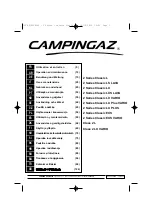
8
Indicating the remaining battery capacity (Fig. 7)
When you pull the switch trigger, the LED display shows
the remaining battery capacity.
The remaining battery capacity is shown as the following
table.
015191
NOTE:
• Approximately one minute after the motor stops, the
indicators go off to save the battery power. To check
the remaining battery capacity, slightly pull the switch
trigger.
Tool / battery protection system
The tool is equipped with a tool/battery protection
system. This system automatically cuts off power to the
motor to extend tool and battery life.
The tool will automatically stop during operation if the
tool or battery are placed under one of the following
conditions. In some conditions, the indicator lights up.
Overload protection
When the tool is operated in a manner that causes it to
draw an abnormally high current, the tool automatically
stops without any indications. In this situation, turn the
tool off and stop the application that caused the tool to
become overloaded. Then turn the tool on to restart.
Overheat protection for tool
When the tool is overheated, the tool stops automatically
and the battery indicator shows following state. In this
situation, let the tool cool before turning the tool on again.
015192
ASSEMBLY
CAUTION:
• Always be sure that the tool is switched off and the
battery cartridge is removed before carrying out any
work on the tool.
Installing or removing driver bit or socket bit
(Fig. 8)
Use only bits that has inserting portion shown in the
figure.
For tool with shallow bit hole
006348
For tool with deep bit hole
011405
Procedure 1 (Fig. 9)
For tool with normal sleeve
To install the bit, pull the sleeve in the direction of the
arrow and insert the bit into the sleeve as far as it will go.
Then release the sleeve to secure the bit.
For tool with one-touch type sleeve
To install the bit, insert the bit into the sleeve as far as it
will go.
Procedure 2 (Fig. 10)
In addition to the procedure (1) above, insert the bit-
piece into the sleeve with its pointed end facing in.
To remove the bit, pull the sleeve in the direction of the
arrow and pull the bit out.
NOTE:
• If the bit is not inserted deep enough into the sleeve,
the sleeve will not return to its original position and the
bit will not be secured. In this case, try re-inserting the
bit according to the instructions above.
• When it is difficult to insert the bit, pull the sleeve and
insert it into the sleeve as far as it will go.
• After inserting the bit, make sure that it is firmly
secured. If it comes out, do not use it.
Hook (Fig. 11)
The hook is convenient for temporarily hanging the tool.
This can be installed on either side of the tool.
To install the hook, insert it into a groove in the tool
housing on either side and then secure it with a screw. To
remove, loosen the screw and then take it out.
OPERATION (Fig. 12 & 13)
CAUTION:
• Never obstruct the air vents on the side of the tool for
cooling down oil unit and motor during operation.
Failure to do so may cause the tool excessive heat and
damage.
The proper fastening torque may differ depending upon
the kind or size of the screw/bolt, the material of the
workpiece to be fastened, etc. The relation between
fastening torque and fastening time is shown in the
figures.
(Fig. 14 & 15)
Battery indicator status
Remaining battery
capacity
:
On :
Off :
Blinking
50% – 100%
20% – 50%
0% – 20%
Charge the
battery
Battery
indicator
: On
: Off
: Blinking
Tool is overheated
A = 12 mm
B = 9 mm
Use only these type of bit. Follow the
procedure (1).
(Note) Bit-piece is not necessary.
A = 17 mm
B = 14 mm
To install these types of bits, follow the
procedure (1).
A = 12 mm
B = 9 mm
To install these types of bits, follow the
procedure (2).
(Note) Bit-piece is necessary for
installing the bit.









































